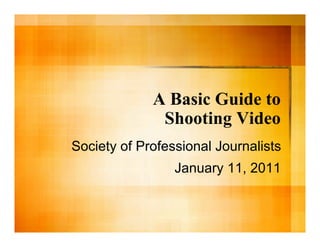OU SPJ: Shooting video 101
- 1. A Basic Guide to Shooting Video Society of Professional Journalists January 11, 2011
- 2. The Camera - Flip Camera - Point & Shoot Camera - Handheld Camera - Professional Camera
- 3. Why learn to shoot? ’ü¼ Quality Video is Invaluable ŌĆō NedaŌĆÖs Death (Iran election fallout) ŌĆō Zapruder Films (JFK Assasination) ŌĆō Virginia Tech Shootings ŌĆō Homeless Man with Golden Voice
- 4. Key Vocabulary ’ü¼ B-roll: Supplemental or alternative footage intercut with the main shot in an interview, documentary, news package. ’ü¼ SOT: Literally means ŌĆ£sound on tape.ŌĆØ It is most often referred to as a ŌĆ£soundbiteŌĆØ and is essentially the broadcast version of a ŌĆ£quote.ŌĆØ
- 5. The Tripod ’ü¼ Used to stabilize the camera. ’ü¼ IMPORTANT: Use a tripod whenever possible. ’ü¼ If you do not have a tripod handy, place the camera on a steady object or lean against your body.
- 6. The Steps: Setting up your Shot 1. Secure the camera on the tripod. 2. Place your subject in front of the subject. 3. When adjusting the height of the tripod, the camera should be eye level with your subject. 1. Inferior 2. Superior
- 7. The Steps: Setting up Your Shot 4. Step to the side of the camera. 1. Make sure that you are eye level with the camera and subject. 5. Ask your subject to look at and talk to you, not the camera. 1. Why?
- 8. Framing the Shot ’ü¼ Rule of thirds ŌĆō Keep your subject in one of the screenŌĆÖs thirds. ŌĆō The subject should always look towards the open space. Good Framing Bad Framing
- 9. Framing the Shot (ctd.) ’ü¼ Leave plenty of room for lower thirds and pay attention to head room. Too much headroom
- 10. Zooming and Panning ’ü¼ Do not zoom or pan. ’ü¼ When these techniques are used, they must be motivated -- there for a reason. DonŌĆÖt use these buttons just because theyŌĆÖre there. ’ü¼ http://www.youtube.com/watch?v=cBtF TF2ii7U&feature=related
- 11. Holding the Shot ’ü¼ Keep each and every shot steady for at least 10 seconds. ’ü¼ Ifyou do not hold your shots, youŌĆÖll kick yourself in the edit process. ’ü¼ Remember not to talk while the camera is recording.
- 12. Cutaways, Sequences, and Transitions ’ü¼ Shoot cutaways, sequences and transitions. TheyŌĆÖre invaluable in the editing process. ’ü¼ Cutaways: Prevent jump cuts and allow you to transition to new material. ŌĆō Examples ’ü¼ Sequence: Close Up, Medium Shot, Wide Shot ŌĆō Instead of Zooming and Panning ŌĆō Movement of the human eye
- 13. Examples of Shots Extreme Wide Shot Very Wide Shot * Images from Mediacollege.com
- 14. Examples of Shots (ctd.) Wide Shot Medium Shot * Images from Mediacollege.com
- 15. Examples of Shots (ctd.) Close Up Extreme Close Up * Images from Mediacollege.com
- 16. Natural Sound ’ü¼ Seek great natural (or ambient) sound. ’ü¼ Examples: water, hammers, plastic, dogs panting, sewing machines, chalk on chalkboard, plastic bags, cheering fans. ’ü¼ http://www.youtube.com/watch?v=LAcIFIASiI 4&feature=related ’ü¼ http://www.msnbc.msn.com/id/3032619/#34 353385
- 17. Headphones ’ü¼ Ifpossible, wear headphones. Otherwise, you donŌĆÖt know what sound youŌĆÖre recording -- or if youŌĆÖre recording any at all.
- 18. Opens and Closes ’ü¼ Always look for a strong open and a memorable close. ŌĆō Tiger Woods Example ’ü¼ Opens and Closes to Avoid: signs, still objects ’ü¼ http://www.msnbc.msn.com/id/3032619 /#34579602
- 19. The Soundbite ’ü¼ Seeksubjective sound bites. Get your subjects to open up and talk. ’ü¼ Emotion, not facts. ’ü¼ ŌĆ£What does this mean to you?ŌĆØ ’ü¼ ŌĆ£How does it make you feel?ŌĆØ
- 20. Other Useful Tips ’ü¼ Toomuch b-roll is better than not enough. ’ü¼ Do not rewind your tape in the field. ’ü¼ How can you make a shot more interesting? ŌĆō Escalator Example.




















